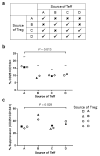A novel and rapid method to quantify Treg mediated suppression of CD4 T cells
- PMID: 28648384
- PMCID: PMC5573621
- DOI: 10.1016/j.jim.2017.06.009
A novel and rapid method to quantify Treg mediated suppression of CD4 T cells
Abstract
Measuring regulatory T cell suppression provides important insight into T cell dysfunction in autoimmune disease. However, to date, suppression assays are limited by the requirement for freshly isolated cells, and significant cell numbers. Here, we present a novel and rapid in vitro assay using effector T cell surface expression of both CD25 and CD134 as a surrogate marker of regulatory T cell-mediated suppression. This surface marker-based suppression assay works for frozen samples and for samples with limited cell numbers. It is also shorter taking two days to complete compared to the four days required for proliferation-based assays. Furthermore, this assay works with both in vitro expanded and natural Tregs, as well as anti-CD3/anti-CD28 bead-based and APC stimulation conditions. In conclusion, we have developed and validated a new suppression assay for cryopreserved samples with limited cell numbers that may be helpful to investigate T cell regulation in the context of infection or autoimmune diseases.
Keywords: CD134; CD25; Proliferation; Regulatory T cells; Suppression assay.
Copyright © 2017 Elsevier B.V. All rights reserved.
Figures





Similar articles
-
Human antigen-specific CD4⁺ CD25⁺ CD134⁺ CD39⁺ T cells are enriched for regulatory T cells and comprise a substantial proportion of recall responses.Eur J Immunol. 2014 Jun;44(6):1644-61. doi: 10.1002/eji.201344102. Epub 2014 Apr 29. Eur J Immunol. 2014. PMID: 24752698 Clinical Trial.
-
Feedback loop of immune regulation by CD4+CD25+ Treg.Immunobiology. 2009;214(4):291-302. doi: 10.1016/j.imbio.2008.09.004. Epub 2008 Nov 1. Immunobiology. 2009. PMID: 19327546
-
IL-10 is required for human CD4(+)CD25(+) regulatory T cell-mediated suppression of xenogeneic proliferation.Immunol Cell Biol. 2010 May-Jun;88(4):477-85. doi: 10.1038/icb.2009.117. Epub 2010 Feb 23. Immunol Cell Biol. 2010. PMID: 20177412
-
A unique subset of CD4+CD25highFoxp3+ T cells secreting interleukin-10 and transforming growth factor-beta1 mediates suppression in the tumor microenvironment.Clin Cancer Res. 2007 Aug 1;13(15 Pt 1):4345-54. doi: 10.1158/1078-0432.CCR-07-0472. Clin Cancer Res. 2007. PMID: 17671115
-
Identification and monitoring of effector and regulatory T cells during experimental arthritis based on differential expression of CD25 and CD134.J Leukoc Biol. 2008 Jan;83(1):112-21. doi: 10.1189/jlb.0607436. Epub 2007 Oct 10. J Leukoc Biol. 2008. PMID: 17928458
Cited by
-
Human regulatory T cells locally differentiate and are functionally heterogeneous within the inflamed arthritic joint.Clin Transl Immunology. 2022 Sep 30;11(10):e1420. doi: 10.1002/cti2.1420. eCollection 2022. Clin Transl Immunology. 2022. PMID: 36204213 Free PMC article.
-
Differential regulation of CD4+ T cell subsets by Silymarin in vitro and in ovalbumin immunized mice.Daru. 2018 Dec;26(2):215-227. doi: 10.1007/s40199-018-0229-x. Epub 2018 Nov 26. Daru. 2018. PMID: 30478656 Free PMC article.
-
Regulatory T cells suppress CD4+ effector T cell activation by controlling protein synthesis.J Exp Med. 2023 Mar 6;220(3):e20221676. doi: 10.1084/jem.20221676. Epub 2023 Jan 4. J Exp Med. 2023. PMID: 36598533 Free PMC article.
-
Single cell suppression profiling of human regulatory T cells.Nat Commun. 2025 Feb 3;16(1):1325. doi: 10.1038/s41467-024-55746-1. Nat Commun. 2025. PMID: 39900891 Free PMC article.
-
In vitro and In vivo CD8+ T Cell Suppression Assays.Bio Protoc. 2021 May 20;11(10):e4020. doi: 10.21769/BioProtoc.4020. eCollection 2021 May 20. Bio Protoc. 2021. PMID: 34150927 Free PMC article.
References
-
- Bacchetta R, Passerini L, Gambineri E, Dai M, Allan SE, Perroni L, Dagna-Bricarelli F, Sartirana C, Matthes-Martin S, Lawitschka A, Azzari C, Ziegler SF, Levings MK, Roncarolo MG. Defective regulatory and effector T cell functions in patients with FOXP3 mutations. J Clin Invest. 2006;116:1713–22. - PMC - PubMed
-
- Chatzigeorgiou A, Lyberi M, Chatzilymperis G, Nezos A, Kamper E. CD40/CD40L signaling and its implication in health and disease. Biofactors. 2009;35:474–83. - PubMed
Publication types
MeSH terms
Substances
Grants and funding
LinkOut - more resources
Full Text Sources
Other Literature Sources
Research Materials

